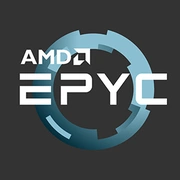AMD EPYC 4464P

The AMD EPYC 4464P processor is a powerhouse for servers with its impressive specs. The 12 total cores and 24 total threads provide exceptional multitasking and processing capabilities, making it ideal for demanding server workloads. The 5 nm technology ensures efficiency and improved performance, while the 32 MB L3 cache further enhances its speed and responsiveness.
The performance-core base frequency of 3.7 GHz and max turbo frequency of 5.4 GHz allows for seamless and rapid processing of complex tasks. The 105W TDP ensures that the processor is able to handle high workloads without overheating or throttling.
One of the standout features of the AMD EPYC 4464P is its integrated Radeon Graphics, providing excellent visual performance and versatility for various server applications.
Overall, the AMD EPYC 4464P is a top-of-the-line processor that delivers exceptional performance and reliability for server usage. Whether it's for data centers, cloud computing, or enterprise-level applications, this processor is a solid choice for anyone in need of a high-performance server CPU.
Basic
Label Name
AMD
Platform
Server
Launch Date
May 2024
Model Name
?
The Intel processor number is just one of several factors - along with processor brand, system configurations, and system-level benchmarks - to be considered when choosing the right processor for your computing needs.
EPYC 4464P
Code Name
Raphael
Foundry
TSMC
Generation
EPYC (Zen 4 (Raphael))
CPU Specifications
Total Cores
?
Cores is a hardware term that describes the number of independent central processing units in a single computing component (die or chip).
12
Total Threads
?
Where applicable, Intel® Hyper-Threading Technology is only available on Performance-cores.
24
Performance-core Base Frequency
3.7 GHz
Performance-core Max Turbo Frequency
?
Maximum P-core turbo frequency derived from Intel® Turbo Boost Technology.
5.4 GHz
L1 Cache
64 KB per core
L2 Cache
1 MB per core
L3 Cache
32 MB shared
Bus Frequency
100 MHz
Multiplier
37.0
Unlocked Multiplier
No
CPU Socket
?
The socket is the component that provides the mechanical and electrical connections between the processor and motherboard.
AMD Socket AM5
Technology
?
Lithography refers to the semiconductor technology used to manufacture an integrated circuit, and is reported in nanometer (nm), indicative of the size of features built on the semiconductor.
5 nm
TDP
105 W
Max. Operating Temperature
?
Junction Temperature is the maximum temperature allowed at the processor die.
61 °C
PCIe Version
?
PCI Express is a high-speed serial computer expansion bus standard used for connecting high-speed components, replacing older standards such as AGP, PCI, and PCI-X. It has gone through multiple revisions and improvements since its initial release. PCIe 1.0 was first introduced in 2002, and in order to meet the growing demand for higher bandwidth, subsequent versions have been released over time.
5
Transistor Count
13.14 billions
Memory Specifications
Memory Type
?
Intel® processors come in four different types: Single Channel, Dual Channel, Triple Channel, and Flex Mode. Maximum supported memory speed may be lower when populating multiple DIMMs per channel on products that support multiple memory channels.
DDR5-5200
Memory Channels
?
The number of memory channels refers to the bandwidth operation for real world application.
2
ECC Memory Support
Yes
GPU Specifications
Integrated Graphics Model
?
An integrated GPU refers to the graphics core that is integrated into the CPU processor. Leveraging the processor's powerful computational capabilities and intelligent power efficiency management, it delivers outstanding graphics performance and a smooth application experience at a lower power consumption.
Radeon Graphics
Miscellaneous
PCIe Lanes
28
Benchmarks
Geekbench 6
Single Core
Score
2918
Geekbench 6
Multi Core
Score
16851
Passmark CPU
Single Core
Score
4183
Passmark CPU
Multi Core
Score
50814
Compared to Other CPU
Geekbench 6 Single Core
Geekbench 6 Multi Core
Passmark CPU Single Core
Passmark CPU Multi Core
Share in social media
Or Link To Us
<a href="https://cputronic.com/en/cpu/amd-epyc-4464p" target="_blank">AMD EPYC 4464P</a>